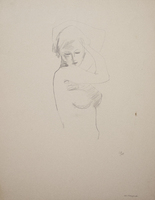Carolyn Pierson Prohaska
Nude (recto and verso)
1983
Graphite on paper
Sheet: 11 in. x 9 in.
Gift of Carolyn Prohaska
Pears
1941
Graphite on paper
Sheet: 9 1/2 in. x 11 1/2 in.
Gift of Carolyn Prohaska
While women artists in general are often highly underrated, most particularly in earlier years, Carolyn Pierson Prohaska (1908-1994) faced this demoting completely as she has been overshadowed by her husband, Ray Prohaska (1901-1981). Ray Prohaska’s biography details his rocky relationship with his father who wanted him to join the army and not go to Fine Arts School. There is, however, little to no published information on Caroyln Prohaska. We do know, however, that Carolyn and Ray met and married in the 1930s, around the time he became a member of Society of Illustrators.1 More specifically they met at an artist party at the residence of James Montgomery Flagg, a famous illustrator and cartoonist. Along with their works, Carolyn and Ray left a legacy of two children who are active in the art world, Tony Prohaska and Elena Prohaska Glen. Both children collaboratively created a show honoring their father’s art and documenting his life as a fisherman. Most information online comes from either Ray’s website created by his son or from news articles about their lives described by their children. Tony and Elena went on to donate works of art produced by both Carolyn and Ray to the Fine Arts Collection at St. Mary’s.
Two of Carolyn’s drawings are in the collection of the College, Nude and Pears. Nude was created in 1983 and is double-sided. The recto consists of a rough sketch of half a female body, from the waist upward. Her arm reaches over her head and her gaze is set below the viewer, towards the ground. The verso depicts a female figure facing away from the viewer, her body hunched, with left arm hidden and right arm extending low, as if she is picking something up. These drawings are accompanied in the collection by her piece Pears, which is another sketch of several pears laying on a flat surface. The drawing includes shading within the pears as well as the surface they appear to be lying on. Prohaska draws the stems as well as darker and lighter areas, suggesting a sort of light coming from the left of the image. One can feel a sense of urgency in the quick sketching movements and lines.
Although there is little information on Carolyn Prohaska’s work as an artist online, there are number examples of her work as a model for photographers.2 She posed for both portraits and artistic nudes. It is unclear if she only modeled for other artists, such as her husband, or if some photographs are her own self-portraits. When interviewed or discussing art, both her children, Elena and Tony, discuss their father in great detail, sometimes even referring to stories told to them by their mother.3 They seldom bring up their mother as her own being, let alone her artwork. It is clear Carolyn’s work and life in general has been overshadowed by her husband’s legacy in the art world as well as within her family.
1. “Biography,” Ray Prohaska. Accessed November 25, 2016, http://rayprohaska.com/biography↩
2. “ACJ - Named Photos / Carolyn Pierson Prohaska,” Historical Ziegfeld Group. Accessed November 26th, 2016. http://historicalzg.piwigo.com/index?/category/928-carolyn_pierson_prohaska_vlad↩
3. Mary Cummings, “A Show Honoring an Artist and His Sea,” The New York Times, September 24, 1995. Accessed December 02, 2016. http://www.nytimes.com/1995.09/24/nyregion/a-show-honoring-an-artist-and-his-sea.html.↩
-Haley Sieglein



